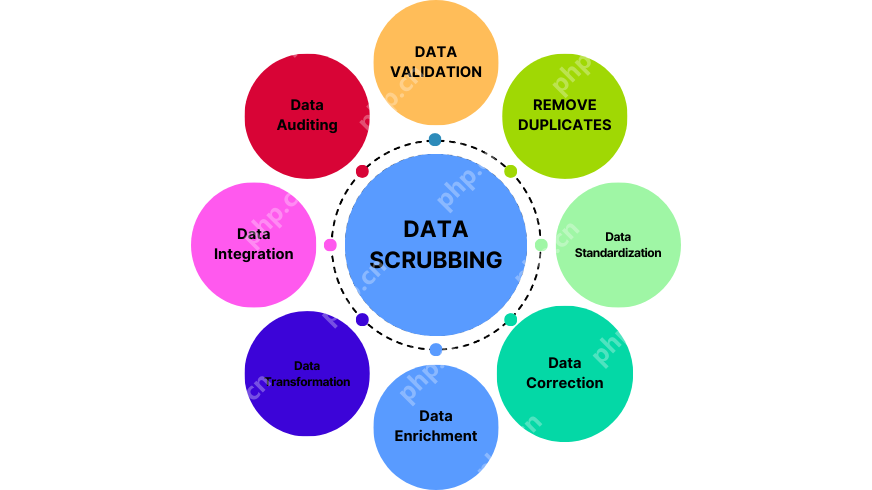Data Cleansing: Ensuring Data Accuracy and Reliability for Informed Decisions
Imagine planning a large family reunion with an inaccurate guest list—wrong contacts, duplicates, misspelled names. A poorly prepared list could ruin the event. Similarly, businesses rely on clean, accurate data for effective operations and strategic decision-making. The process of cleaning and correcting data—ensuring accuracy, removing duplicates, and updating information—is known as data scrubbing or data cleansing. Just as meticulous planning ensures a successful reunion, data scrubbing improves business performance and decision-making.

Key Aspects of Data Cleansing:
- Understanding the critical role of data cleansing.
- Exploring effective data cleansing techniques and tools.
- Identifying common data quality problems and their solutions.
- Implementing data cleansing strategies within your organization.
- Addressing and mitigating potential challenges in the data cleansing process.
Table of Contents:
- Introduction
- What is Data Cleansing?
- The Data Cleansing Process: A Step-by-Step Guide
- Techniques and Tools for Data Cleansing
- The Importance of Data Cleansing
- Addressing Common Data Quality Issues
- Best Practices for Data Cleansing
- Challenges in Data Cleansing
- Conclusion
- Frequently Asked Questions
What is Data Cleansing?
Data cleansing is a crucial data management process that identifies and rectifies data errors, inconsistencies, and inaccuracies. These issues can arise from various sources, including incorrect data entry, database problems, and merging data from multiple sources. Clean data is essential for accurate analysis, reporting, and effective decision-making.
The Data Cleansing Process: A Step-by-Step Guide
Data cleansing is an iterative process involving several key steps:

- Data Validation: Verifying data accuracy and consistency against predefined rules and formats (e.g., ensuring dates are in YYYY-MM-DD format).
- Duplicate Detection and Removal: Identifying and eliminating duplicate entries resulting from data entry errors or system issues.
- Data Standardization: Converting data into a consistent format across different sources (e.g., standardizing currency or date formats).
- Data Correction: Rectifying errors such as typos, incorrect entries, and outdated information.
- Data Enrichment: Supplementing existing data with missing information from external sources or updating records with current details.
- Data Transformation: Converting data into a format suitable for analysis and reporting (e.g., aggregating data or creating calculated fields).
- Data Integration: Combining data from multiple sources into a unified and consistent format.
- Data Auditing: Regularly reviewing data quality and the effectiveness of the cleansing process to ensure ongoing data integrity.
Techniques and Tools for Data Cleansing
Effective data cleansing relies on a combination of techniques and tools:
Techniques:
- Data Validation: Verifying data against predefined rules.
- Data Parsing: Breaking down data into smaller units for error detection.
- Data Standardization: Ensuring consistent data formats.
- Duplicate Removal: Identifying and removing duplicate records.
- Error Correction: Manually or automatically fixing identified errors.
- Data Enrichment: Adding missing or enhancing existing data.
Tools:
- OpenRefine: A powerful open-source tool for data cleaning and transformation.
- Trifacta: An AI-powered data preparation platform.
- Talend: An ETL (Extract, Transform, Load) tool with data cleansing capabilities.
- Data Ladder: A data matching and deduplication tool.
- Pandas (Python Library): A versatile Python library for data manipulation and cleaning.
The Importance of Data Cleansing
Data cleansing offers numerous benefits:
- Improved Decision-Making: Accurate data leads to better informed and more effective decisions.
- Increased Efficiency: Clean data streamlines processes, reducing time spent on error correction.
- Enhanced Customer Relations: Accurate customer data improves customer service and loyalty.
- Regulatory Compliance: Ensures adherence to data privacy and accuracy regulations.
- Cost Savings: Prevents wasted resources due to inaccurate or incomplete data.
- Better Data Integration: Facilitates seamless integration of data from various sources.
- More Accurate Analytics and Reporting: Clean data ensures reliable insights from analytics and reporting.
Addressing Common Data Quality Issues
Common data quality issues and their solutions:
- Missing Values: Imputation (estimating missing values) or removal of incomplete records.
- Inconsistent Data Formats: Standardization of formats (dates, addresses, etc.).
- Duplicate Records: Algorithms to identify and merge or remove duplicates.
- Outliers: Investigation to determine if they are errors or valid data points.
- Incorrect Data: Validation against trusted sources or automated correction.
Best Practices for Data Cleansing
- Establish Data Quality Standards: Define clear criteria for data accuracy and consistency.
- Automate Where Possible: Utilize data cleaning tools and scripts to automate the process.
- Regularly Review and Update Data: Data cleansing is an ongoing process.
- Involve Data Owners: Collaborate with individuals familiar with the data.
- Document Your Process: Maintain detailed records of cleansing activities and decisions.
Challenges in Data Cleansing
- Large Data Volumes: Processing massive datasets can be computationally intensive.
- Data Complexity: Handling various data types and structures.
- Lack of Standardization: Inconsistent data standards across different sources.
- Resource Intensity: Requires significant human and technical resources.
- Continuous Process: Maintaining data quality requires ongoing effort.
Conclusion
Data cleansing is critical for ensuring data accuracy and reliability, leading to better decision-making and improved business outcomes. While challenges exist, the benefits of implementing effective data cleansing strategies far outweigh the effort involved. Investing in data cleansing is an investment in the quality and value of your data.
Frequently Asked Questions
Q1. What is data cleansing? A. Data cleansing is the process of identifying and correcting or removing inaccurate, incomplete, irrelevant, duplicated, or improperly formatted data.
Q2. Why is data cleansing important? A. Data cleansing ensures data accuracy, consistency, and reliability, crucial for informed decision-making, efficient operations, and regulatory compliance.
Q3. What are some common data quality issues? A. Common issues include missing values, inconsistent formats, duplicates, outliers, and incorrect data.
Q4. What tools can be used for data cleansing? A. Tools like OpenRefine, Trifacta, Talend, and Pandas are commonly used.
Q5. What are the challenges in data cleansing? A. Challenges include data volume, complexity, lack of standardization, resource requirements, and the ongoing nature of the process.
The above is the detailed content of What is Data Scrubbing?. For more information, please follow other related articles on the PHP Chinese website!

Hot AI Tools

Undress AI Tool
Undress images for free

Undresser.AI Undress
AI-powered app for creating realistic nude photos

AI Clothes Remover
Online AI tool for removing clothes from photos.

Clothoff.io
AI clothes remover

Video Face Swap
Swap faces in any video effortlessly with our completely free AI face swap tool!

Hot Article

Hot Tools

Notepad++7.3.1
Easy-to-use and free code editor

SublimeText3 Chinese version
Chinese version, very easy to use

Zend Studio 13.0.1
Powerful PHP integrated development environment

Dreamweaver CS6
Visual web development tools

SublimeText3 Mac version
God-level code editing software (SublimeText3)

Hot Topics
 AI Investor Stuck At A Standstill? 3 Strategic Paths To Buy, Build, Or Partner With AI Vendors
Jul 02, 2025 am 11:13 AM
AI Investor Stuck At A Standstill? 3 Strategic Paths To Buy, Build, Or Partner With AI Vendors
Jul 02, 2025 am 11:13 AM
Investing is booming, but capital alone isn’t enough. With valuations rising and distinctiveness fading, investors in AI-focused venture funds must make a key decision: Buy, build, or partner to gain an edge? Here’s how to evaluate each option—and pr
 AGI And AI Superintelligence Are Going To Sharply Hit The Human Ceiling Assumption Barrier
Jul 04, 2025 am 11:10 AM
AGI And AI Superintelligence Are Going To Sharply Hit The Human Ceiling Assumption Barrier
Jul 04, 2025 am 11:10 AM
Let’s talk about it. This analysis of an innovative AI breakthrough is part of my ongoing Forbes column coverage on the latest in AI, including identifying and explaining various impactful AI complexities (see the link here). Heading Toward AGI And
 Kimi K2: The Most Powerful Open-Source Agentic Model
Jul 12, 2025 am 09:16 AM
Kimi K2: The Most Powerful Open-Source Agentic Model
Jul 12, 2025 am 09:16 AM
Remember the flood of open-source Chinese models that disrupted the GenAI industry earlier this year? While DeepSeek took most of the headlines, Kimi K1.5 was one of the prominent names in the list. And the model was quite cool.
 Future Forecasting A Massive Intelligence Explosion On The Path From AI To AGI
Jul 02, 2025 am 11:19 AM
Future Forecasting A Massive Intelligence Explosion On The Path From AI To AGI
Jul 02, 2025 am 11:19 AM
Let’s talk about it. This analysis of an innovative AI breakthrough is part of my ongoing Forbes column coverage on the latest in AI, including identifying and explaining various impactful AI complexities (see the link here). For those readers who h
 Grok 4 vs Claude 4: Which is Better?
Jul 12, 2025 am 09:37 AM
Grok 4 vs Claude 4: Which is Better?
Jul 12, 2025 am 09:37 AM
By mid-2025, the AI “arms race” is heating up, and xAI and Anthropic have both released their flagship models, Grok 4 and Claude 4. These two models are at opposite ends of the design philosophy and deployment platform, yet they
 Chain Of Thought For Reasoning Models Might Not Work Out Long-Term
Jul 02, 2025 am 11:18 AM
Chain Of Thought For Reasoning Models Might Not Work Out Long-Term
Jul 02, 2025 am 11:18 AM
For example, if you ask a model a question like: “what does (X) person do at (X) company?” you may see a reasoning chain that looks something like this, assuming the system knows how to retrieve the necessary information:Locating details about the co
 Senate Kills 10-Year State-Level AI Ban Tucked In Trump's Budget Bill
Jul 02, 2025 am 11:16 AM
Senate Kills 10-Year State-Level AI Ban Tucked In Trump's Budget Bill
Jul 02, 2025 am 11:16 AM
The Senate voted 99-1 Tuesday morning to kill the moratorium after a last-minute uproar from advocacy groups, lawmakers and tens of thousands of Americans who saw it as a dangerous overreach. They didn’t stay quiet. The Senate listened.States Keep Th
 This Startup Built A Hospital In India To Test Its AI Software
Jul 02, 2025 am 11:14 AM
This Startup Built A Hospital In India To Test Its AI Software
Jul 02, 2025 am 11:14 AM
Clinical trials are an enormous bottleneck in drug development, and Kim and Reddy thought the AI-enabled software they’d been building at Pi Health could help do them faster and cheaper by expanding the pool of potentially eligible patients. But the






